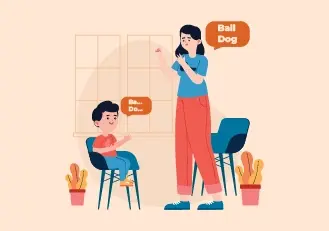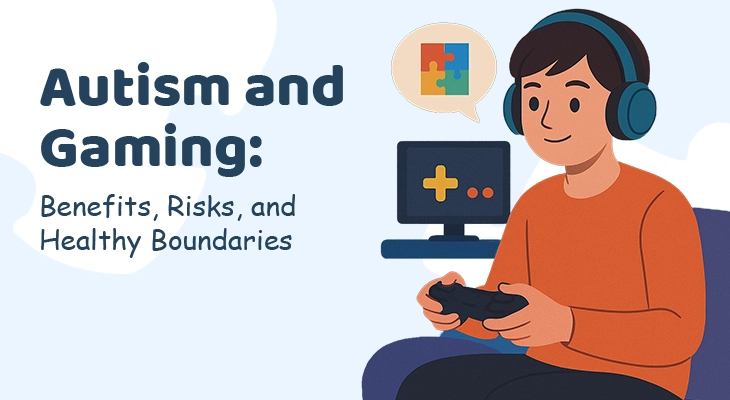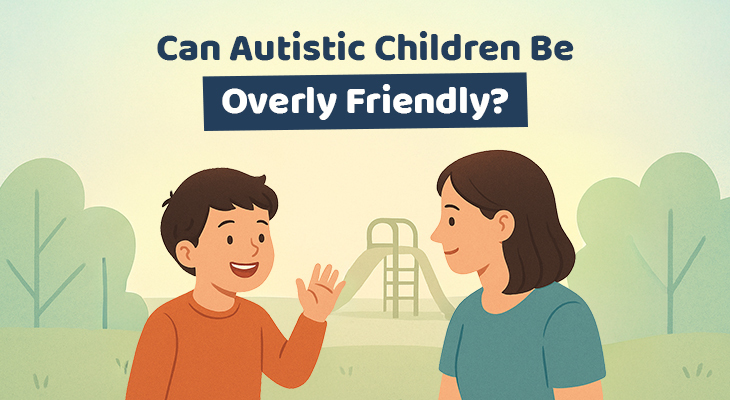John, a bright eight-year-old with autism, possesses a vast knowledge of dinosaurs. He can recite their scientific names, describe their habitats, and even mimic their roars with impressive accuracy. However, when it comes to expressing his own needs and wants, John often resorts to frustration and repetitive phrases. While he understands spoken language, forming his own sentences can be a daunting task. John’s speech delay, a common symptom of autism, manifests in limited vocabulary, difficulty with sentence structure, and occasional echolalia.
In this blog, we’ll delve into the different types of speech delay in autism, explore its hidden complexities you may not know, and highlight the crucial role of early intervention in unlocking the true communication potential of autistic children with speech delays.
Table of Contents
- What is speech delay in autism and what are its types?
- Speech delay in autism vs language delay in autism: Are they the same?
- Developmental milestones for speech delay
- When does a speech delay signal autism?
- Negative impact of speech and language delay in autism
- Impact of early intervention on speech development
- Conclusion
- Did You Know About Folate Receptor Autoantibodies (FRAAs) and Brain Development?
- References
What is speech delay in autism?
Speech delay in autism involves difficulties with communication skills, particularly spoken language, compared to developmental expectations for a child’s age. Speech delay in autism is a common, but not universal, characteristic of Autism Spectrum Disorder (ASD) and can manifest in various ways, including:
- Delayed onset of speech: Some children with ASD may not start speaking until later than the typical age range (12-18 months).
- Limited vocabulary: They may have fewer words than their peers and may struggle to learn new ones.
- Difficulties with sentence structure: They may form grammatically incorrect sentences or use single words rather than full sentences to communicate.
- Articulation problems: They may have trouble pronouncing certain sounds or words clearly.
- Echolalia: They may repeat back words or phrases they hear without truly understanding their meaning. Unveiling the mysteries of echolalia in autism can be key to understanding and supporting children with speech delays. Discover more in our blog, Echolalia in Autism: Causes, Types, Reasons, Treatment and Support.
- Nonverbal communication challenges: They may have difficulty with gestures, facial expressions, and eye contact, further hindering communication.
It’s important to note that not all children with speech delays have autism, and not all children with autism have speech delays. The presence of other autistic symptoms, like difficulties with social interaction and repetitive behaviors, is crucial for diagnosis.

Speech delay in #autism isn’t just late talking. It’s trouble forming words & sentences, & can impact understanding. Learn more about types, causes, & support: https://bit.ly/4b119jH
#SpeechDelay #AutismAwareness #UnderstandingAutism #FRAT
Speech delay in autism vs language delay in autism: Are they the same?
While both speech and language delays are common in autism, they’re not the same thing. Here’s how to decipher the nuances:
Speech delay: Think of it as the mechanics of talking. It includes forming sounds, pronouncing words, and putting them together fluently. A child with a speech delay might understand you perfectly, but they might struggle to express themselves clearly.
Language delay: This goes beyond words. It’s the entire system of understanding and using communication to convey meaning. Imagine a child who speaks clearly but can’t form sentences, tell stories, or understand simple instructions. They likely have a language delay.
The overlap: Remember, these are not watertight categories. Some children might struggle with both, while others excel in one area but lag in another. A child might mix clear words with jumbled phrases, highlighting a mix of strengths and challenges.
Importance of knowing the difference: Recognizing the specific type of delay can guide you toward appropriate support. Speech therapy focuses on the physical aspects of speech production, while language therapy helps develop expressive and receptive language skills.

Download Download & share this infograph in your network [Free Download]
Language & Communication Developmental Milestones for Neurotypical Children
Before we delve into the world of “typical” language development, let’s remember that every child progresses at their own pace, and variations are perfectly normal. This section serves as a guidepost, not a rigid schedule, to help you understand the general trajectory of language & communication acquisition in neurotypical children.
Video credit: CDC, Important Milestones: Your baby by 2 months
Makes sound other than crying
Video credit: CDC, Important Milestones: Your baby by 2 months
Reacts to loud sounds
Video credit: CDC, Important Milestones: Your baby by 4 months
Makes sounds like “oooo”, “aahh” (cooing)
Video credit: CDC, Important Milestones: Your baby by 4 months
Makes sounds back when you talk to him
Video credit: CDC, Important Milestones: Your baby by 4 months
Turns head towards the sound of your voice
Video credit: CDC, Important Milestones: Your baby by 6 months
Takes turns making sounds with you
Video credit: CDC, Important Milestones: Your baby by 6 months
Blows “raspberries” (sticks tongue out and blows)
Video credit: CDC, Important Milestones: Your baby by 6 months
Makes squealing noises
Video credit: CDC, Important Milestones: Your baby by 9 months
Makes a lot of different sounds like “mamamama” and “dadadada”
Video credit: CDC, Important Milestones: Your baby by 9 months
Lifts arms up to be picked up
Video credit: CDC, Important Milestones: Your baby by 1 year
Waves “bye-bye”
Video credit: CDC, Important Milestones: Your baby by 1 year
Calls a parent “mama” or “dada” or another special name
Video credit: CDC, Important Milestones: Your baby by 1 year
Understands “no” (pauses briefly or stops when you say it)

Tries to say one or two words besides “mama” or “dada,” like “ba” for ball or “da” for dog
Video credit: CDC, Important Milestones: Your baby by 15 months
Looks at a familiar object when you name it
Video credit: CDC, Important Milestones: Your baby by 15 months
Follows directions given with both a gesture and words. For example, he gives you a toy when you hold out your hand and say, “Give me the toy.”
Video credit: CDC, Important Milestones: Your baby by 15 months
Points to ask for something or to get help
Video credit: CDC, Important Milestones: Your baby by 18 month
Tries to say three or more words besides “mama” or “dada”
Video credit: CDC, Important Milestones: Your baby by 18 months
Follows one-step directions without any gestures, like giving you the toy when you say, “Give it to me.”
Video credit: CDC, Important Milestones: Your baby by 2 years
Points to things in a book when you ask, like “Where is the bear?”
Video credit: CDC, Important Milestones: Your baby by 2 years
Says at least two words together, like “More milk.”
Video credit: CDC, Important Milestones: Your baby by 2 years
Points to at least two body parts when you ask him to show you
Video credit: CDC, Important Milestones: Your baby by 2 years
Uses more gestures than just waving and pointing, like blowing a kiss or nodding yes
Video credit: CDC, Important Milestones: Your baby by 30 months
Says about 50 words
Video credit: CDC, Important Milestones: Your baby by 30 months
Says two or more words together, with one action word, like “Doggie run”
Video credit: CDC, Important Milestones: Your baby by 30 months
Names things in a book when you point and ask, “What is this?”
Video credit: CDC, Important Milestones: Your baby by 30 months
Says words like “I,” “me,” or “we”
Video credit: CDC, Important Milestones: Your baby by 3 years
Talks with you in conversation using at least two back-and-forth exchanges
Video credit: CDC, Important Milestones: Your baby by 3 years
Asks “who,” “what,” “where,” or “why” questions, like “Where is mommy/daddy?”
Video credit: CDC, Important Milestones: Your baby by 3 years
Says what action is happening in a picture or book when asked, like “running,” “eating,” or “playing”
Video credit: CDC, Important Milestones: Your baby by 3 years
Says first name, when asked
Video credit: CDC, Important Milestones: Your baby by 3 years
Talks well enough for others to understand, most of the time
Video credit: CDC, Important Milestones: Your baby by 4 years
Says sentences with four or more words
Video credit: CDC, Important Milestones: Your baby by 4 years
Says some words from a song, story, or nursery rhyme
Video credit: CDC, Important Milestones: Your baby by 4 years
Talks about at least one thing that happened during her day, like “I played soccer.”
Video credit: CDC, Important Milestones: Your baby by 4 years
Answers simple questions like “What is a coat for?” or “What is a crayon for?”
Video credit: CDC, Important Milestones: Your baby by 5 years
Tells a story she heard or made up with at least two events. For example, a cat was stuck in a tree and a firefighter saved it
Video credit: CDC, Important Milestones: Your baby by 5 years
Answers simple questions about a book or story after you read or tell it to him
Video credit: CDC, Important Milestones: Your baby by 5 years
Keeps a conversation going with more than three back-and-forth exchanges
Video credit: CDC, Important Milestones: Your baby by 5 years
Uses or recognizes simple rhymes (bat-cat, ball-tall)
When does a speech delay signal autism?
Speech delays are common in many children, and while they can be a symptom of autism spectrum disorder (ASD), they’re not always definitive signs. Every child develops at their own pace, and individual differences exist within the spectrum of autism. But when should alarm bells start ringing? Here are some red flags to consider:
- Delayed onset of speech: Not saying first words by 12-18 months or saying fewer words than expected for their age.
- Limited vocabulary and slow vocabulary growth: Not acquiring new words at a typical pace or having a significantly smaller vocabulary than peers.
- Difficulties with sentence structure: Struggling to form grammatically correct sentences, using mostly single words, or having awkward phrasing.
- Articulation problems: Difficulty pronouncing certain sounds clearly or having a noticeably different speech pattern.
- Echolalia: Repeating back phrases or words without understanding their meaning or using them in inappropriate contexts.
- Nonverbal communication challenges: Lack of eye contact, limited gestures, and difficulty understanding nonverbal cues.
- Social communication difficulties: Difficulty initiating or maintaining conversations, showing limited interest in social interaction, or displaying unusual play patterns.
Unnerving silence where first words should be. Awkward phrases instead of flowing conversations. These are just a few red flags that might raise concerns about speech delays in children. But before leaping to conclusions, let’s delve deeper. In our blog, Decoding Autism: Essential Tests and Key Indicators You Can’t Afford to Ignore, we explore crucial tests and indicators of Autism you need to know. Read it to dive in with us and empower yourself to navigate this complex journey with clarity and confidence.
Negative impact of speech and language delay in autism
Speech and language delay can significantly impact an individual’s quality of life in various ways:
-
Communication Challenges:
- Difficulty expressing needs, wants, and emotions, leading to frustration, misunderstandings, and social isolation.
- Limited ability to participate in conversations and build relationships, affecting social development and friendships.
- Potential for misinterpretations and behavioral outbursts due to inability to effectively communicate their intentions.
-
Learning and Education:
- Difficulty following instructions, understanding concepts, and participating in classroom activities.
- Lower academic performance and potential delays in educational progress.
- Increased reliance on alternative means of communication, which may not be readily available or accepted in all settings.
-
Mental Health and Wellbeing:
- Increased risk of anxiety, depression, and low self-esteem due to communication difficulties and social isolation.
- Frustration and difficulty regulating emotions, potentially leading to behavioral challenges.
- Feeling misunderstood and isolated, negatively impacting social-emotional development and overall well-being.
-
Social Participation and Inclusion:
- Difficulty initiating and maintaining friendships and participating in social activities.
- Feeling excluded from social interactions and peer groups, leading to loneliness and isolation.
- Missed opportunities for social learning and development, impacting interpersonal skills and overall social competence.
-
Quality of Life for Families:
- Increased stress and burden on families due to communication challenges and behavioral difficulties.
- Challenges in navigating social situations and accessing appropriate support services.
- Emotional strain and worry about the child’s development and future.
-
Impact of early intervention on speech development:
Early intervention for speech delay in autism is crucial to mitigate these negative impacts and improve quality of life. Through comprehensive and individualized therapy, children can develop:
- Effective communication skills
- Stronger social and emotional skills
- Improved academic performance
- Better self-esteem and confidence
- Greater independence and participation in their communities
Early intervention with proven methods is crucial, enhancing the quality of life for individuals with autism and their families. We recommend reading our blog Early Intervention in Autism (ASD) – A Life-Changing Opportunity which explores the why and how of early intervention.
Conclusion
Decoding the complexities of speech delay in autism isn’t just about understanding the challenges; it’s about unlocking the potential that lies within. Early intervention is the key, a powerful tool to bridge the communication gap and empower autistic children to express themselves, connect with the world, and thrive. Let this blog be the starting point for your journey, a guide to navigate the path towards early support and unleash the true voice of your child. Remember, every word, every sentence, every connection built is a victory worth celebrating. Take action, embrace the resources available, and rewrite the narrative of speech delay into one of hope, progress, and endless possibilities.




